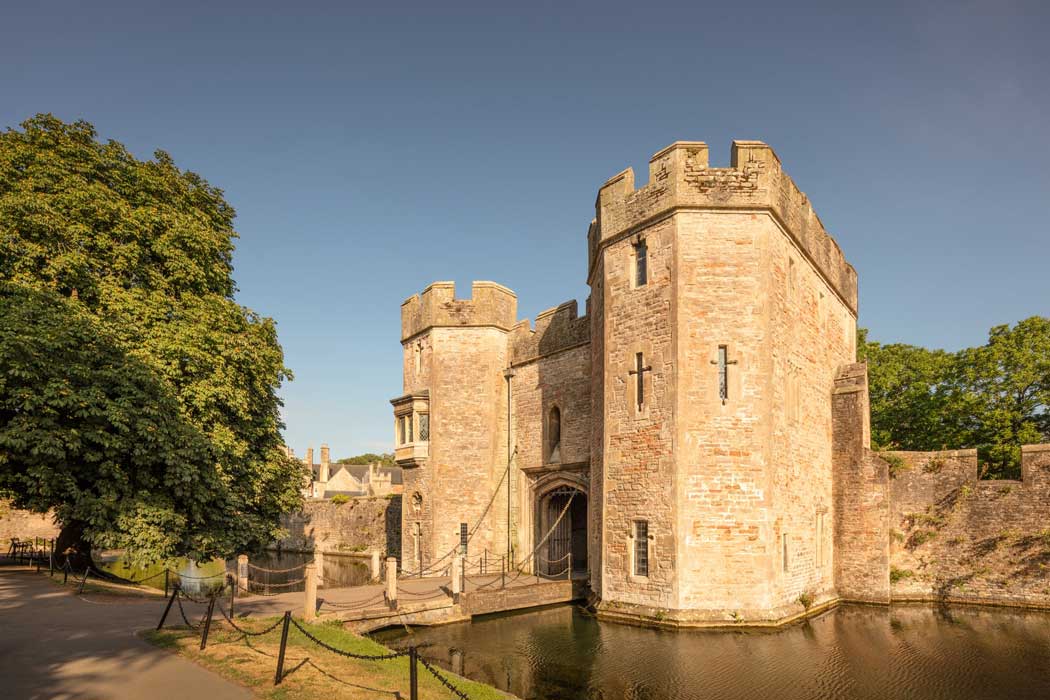The Bishop’s Palace and Gardens in Wells has been the home to the Bishops of Bath and Wells for over 800 years. Although the great hall is in ruins, the palace is mostly well maintained and features a Jacobean staircase and Victorian Gothic rooms where you can see the Coronation Cape and the Glastonbury Chair.
Construction began around 1210 and was overseen by Bishops Jocelin of Wells and Reginald Fitz Jocelin and, like many buildings from this period, it was expanded upon over the years with the chapel and great hall added between 1275 and 1292 and in the 14th century, Bishop Ralph of Shrewsbury added the gatehouse, walls and moat. The gardens were laid out in the 1820s.
The Bishop’s Palace has been used as a filming location for several films and television shows including Hot Fuzz (2007), The Huntsman (2016) and series three of Poldark.
What to see at the Bishop’s Palace
Most of the palace is now open to the public, however, it remains the residence of the current bishop. Visitors to the Bishop’s Palace can see the chapel, the long gallery and the undercroft.
The walled palace precinct is accessible through the Bishop’s Eye, an archway in the three-storey gatehouse.

The Bishop’s Palace is a two-storey Grade I listed building with flagstone floors and a 16th-century stone fireplace. The building is laid out with a hall, a solar (a room that offered a greater level of privacy than the main hall), the long gallery and a medieval vaulted undercroft.
The long gallery features portraits of former bishops and the palace’s other publicly accessible rooms contain a number of exhibits of artefacts where you can learn more about the building’s history and the role it played in society. The highlight of these exhibits includes one of only two surviving Glastonbury chairs.
The chapel and the ruins of the palace’s great hall are located to the right of the palace. Both date from the 13th century.
The chapel represents an excellent example of the Decorated Gothic architectural style that was popular in the late 13th to late 14th centuries although it does have some more recent additions including French stained glass taken from churches that were abandoned or damaged during the French Revolution. It remains a working chapel with services on Tuesdays and Wednesdays.
Although only two walls of the great hall survive, it is still considered to be an excellent example of a medieval open hall and it is noted for its large windows, which are typical of the Early English Decorative style.
![The chapel and the wall of the great hall, which both date from the 13th century. (Photo: Ad Meskens [CC BY-SA 4.0])](https://englandrover.com/wp-content/uploads/2018/09/bishops-palace-wells-chapel-great-hall.jpg)
The 5.7ha (14 acres) of Grade II* listed gardens include St Andrews Spring, which supplies one of the wells for which the city is named and most of what visitors see in the gardens today dates back to the 1820s when Bishop George Henry Law landscaped the grounds. This includes a reflecting pool that provides a lovely foreground to Wells Cathedral.
The gardens are home to mute swans that have been trained to ring bells to beg for food.
The Wells Moat Boat Race takes place annually during the August bank holiday.
![An aerial view of the Bishop's Palace in Wells showing the moat, the gatehouse (bottom right), the remaining walls of the great hall (top), the palace and the chapel (left) and the current bishop's residence (bottom left). (Photo: Edwin Graham [CC BY-SA 2.0])](https://englandrover.com/wp-content/uploads/2018/09/bishops-palace-wells-aerial.jpg)
Visiting the Bishop’s Palace
The Bishop’s Palace and Gardens are located adjacent to Wells Cathedral at the northern end of Wells’ city centre.
It is a relatively expensive attraction, although this is offset somewhat by the free entrance to Wells Cathedral. HHA (Historic Houses Association) members get free entry to the palace and gardens, except during special events.
The palace and gardens are open daily with shorter hours during winter. There are also guided tours that operate several times a day. The site is occasionally closed for filming and private events.
The Bishop’s Table is a lovely cafe overlooking the croquet lawn. It is a nice spot for a light lunch and anyone can visit as it is located past the gatehouse but before the main entrance to the palace.
Allow around two hours to visit the Bishop’s Palace.


There are no comments yet.